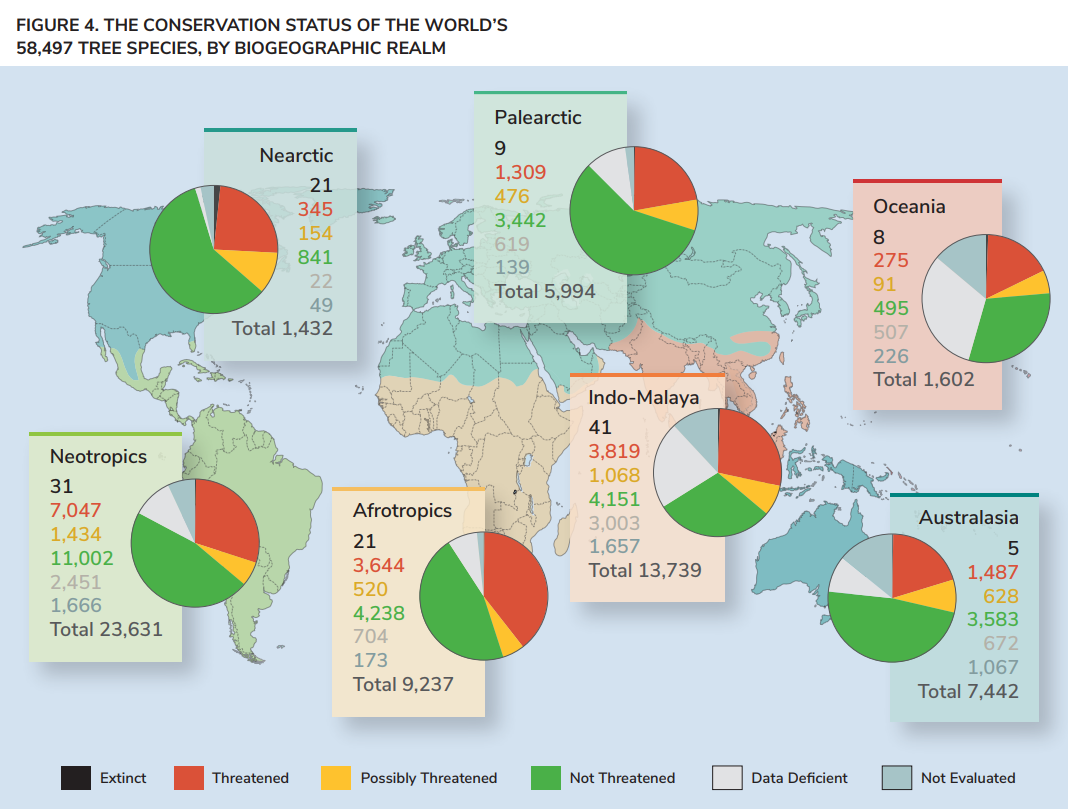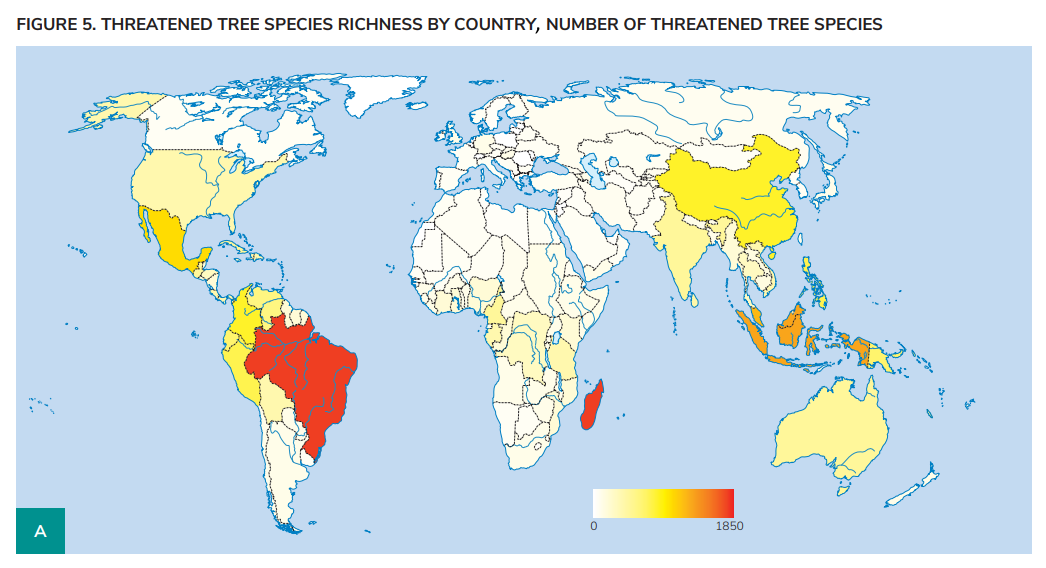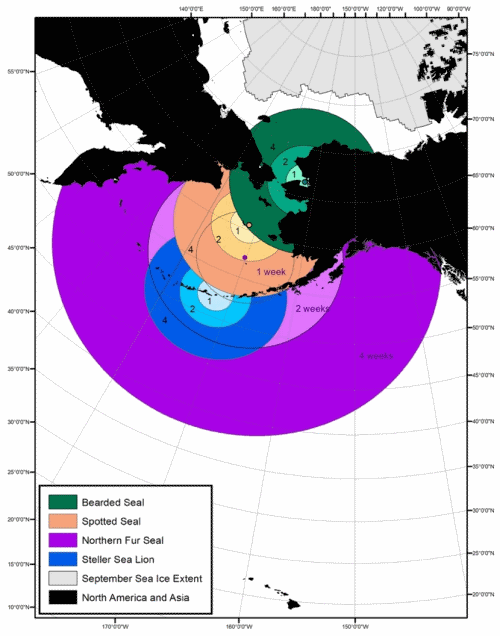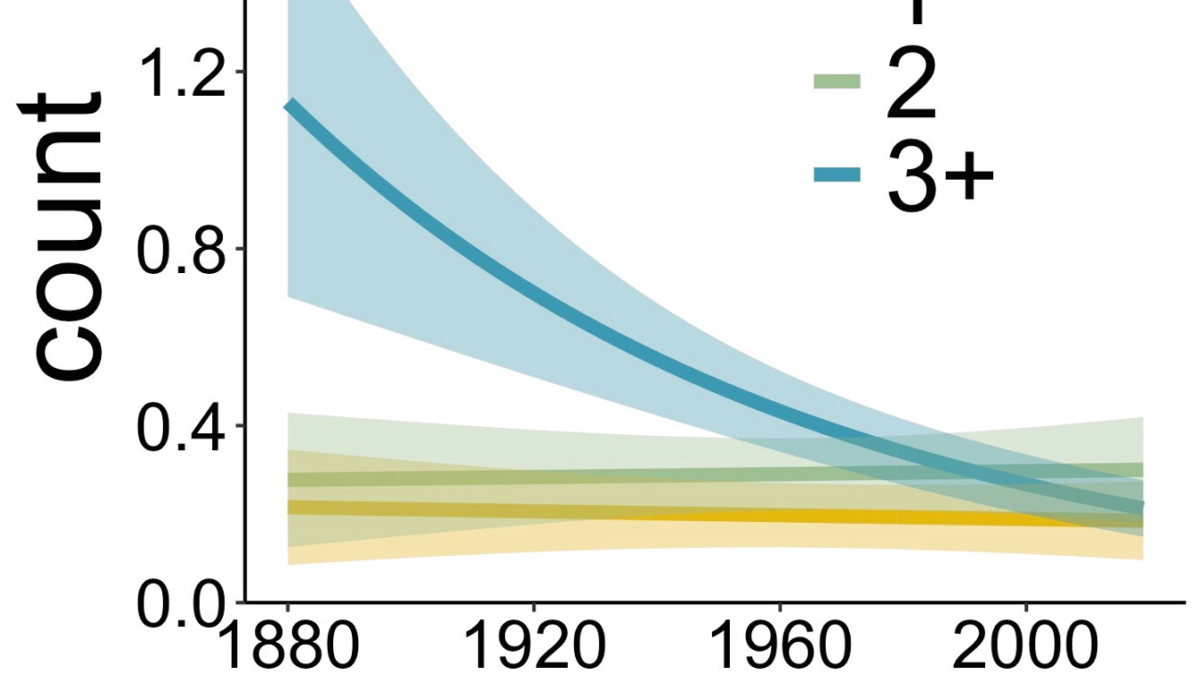At least one-third of Earth’s trees face extinction – Scientists issue “warning to humanity” that tree species extinction could bring economic as well as ecosystem crisis
LONDON, 1 September 2022 (BGCI) – Today a new paper by leading scientists and the Botanic Gardens Conservation International (BGCI) reveals the severe impact that tree species extinction will have on other species, ecosystems and livelihoods. This comes exactly one year on from the landmark State of the World’s Trees report, which examined global tree species and found that a third of the world’s tree species (17,510) are currently at risk of extinction. [The late Gail Zawacki would have felt vindicated by this report. I wish she had lived long enough to see it. –Des]
A year on from the findings, scientists from IUCN SSC Global Tree Specialist Group and BGCI have today issued a “warning to humanity” to raise awareness of the tree species extinction crisis, which is a major environmental issue. The call to action, which comes months ahead of the Kunming Biodiversity Conference 2022 where leaders will meet to discuss biodiversity decline, highlights the urgent need for tree species conservation and identifies key priority actions for Governments.
Trees are of exceptional ecological importance, playing a vital role in many of the world’s ecosystems and supporting other plants, fungi and animal species. Half of the world’s known animal and plant species rely on trees for their habitat, while forests provide 50% of the world’s carbon storage and ¾ of the world’s accessible freshwater.
Many tree species are also of direct value to people, providing a range of socio-economic benefits, such as contributing to food security and meeting energy, health, housing, income and nutritional needs. The world’s forests contribute approximately $1.3 trillion to the global economy, timbers are the highest valued commodity, but non-timber products, such as fruit, nuts, and medicine contributing $88 billion in global trade, and providing 20-25% of household income in developing countries.
Trees have intrinsic value and hold important cultural significance, providing both aesthetic value and recreation but also often strengthening community relations, cultural connections, spirituality and sense of place. Many indigenous communities depend on trees for cultural identity, heritage and knowledge as particular tree species are linked with tribal identities and customs. The livelihoods of the Pewenche people of southern South America, for example, are traditionally dependent on the Endangered conifer Araucaria araucana; with their tribal name being derived from the species.

The impact of tree species loss
The paper warns that the loss of tree diversity through the large-scale extinction of tree species, will lead to major biodiversity losses and substantially alter the cycling of carbon, water and nutrients in the world’s ecosystems. Over 100 tree species are already Extinct in the wild, and with billions of trees being destroyed each year, a third of species face extinction. Tree species extinction has severe ecological implications, as it will undermine processes like soil formation and climate regulation, reducing the ability of forests to tolerate climate change.
Many threatened tree species provide the habitat and food for millions of other species of birds, mammals, amphibians, reptiles, insects and microorganisms. In fact, the world’s forests contain approximately 75% of bird species, 68% of the world’s mammal species and are home to over 10 million species of invertebrates. Forest-dependent species have already declined by around 53% since 1970.
The paper also reveals the extent that tree extinction will undermine the livelihoods of the billions of people around the world who currently depend on trees and the benefits they provide, having severe economic impacts and adverse effects on human health and wellbeing. Worldwide, more than 1.6 billion people live within 5km of a forest and rely on it for jobs and income while 53% of the fruit available for consumption globally is produced by trees.
Last year we published the State of the World’s Trees report, which showed that a third of species are at risk of extinction. In this new paper, we show the wide-ranging impact these tree extinctions may have on other species, on the ecosystems and for humanity. A strong and urgent response is required, both to prevent further tree species extinctions and restore the damaged ecosystems they form a part of.
Malin Rivers, lead author and Head of Conservation Prioritisation at BGCI
The paper also outlines why some tree species are ‘irreplaceable’, in that they have district traits that provide unique environmental benefits which cannot be replaced or replicated by other species. This is especially true for “rare tree” species such as the Brandegee Oak (Quercus brandegeii), the Dragonsblood Tree in Socotra and the Gomortega keule in Chile and emphasises the importance of specifically protecting threatened trees. The extinction of a single tree species can alter an ecosystem substantially, causing a domino effect in the form of ‘extinction cascades’, which would see the rapid decline of ecosystem functions. This includes species of Eucalyptus and Dipterocarp trees which, when destroyed, mean forests are more at risk from fire and pests and disease.
Currently there are more threatened tree species listed on the International Union for Conservation of Nature (IUCN) Red List than the number of threatened mammals, birds, reptiles and amphibians combined, and yet tree species under threat of extinction are often overlooked, and other threatened species groups are typically used as flagships for biodiversity conservation.
The lack of consideration for tree biodiversity promoted the development of the BGCI’s Global Biodiversity Standard, the world’s first and only standard to ensure large tree planting efforts are diverse, and are planting the “right tree in the right place,” instead of having a damaging impact on the environment.

A call to action
This new scientists’ warning to humanity from BGCI and IUCN SSC Global Tree Specialist Group aims to raise awareness of the tree extinction crisis and to provide a catalyst for policymakers and conservation experts to take action.
The paper puts forward seven urgent actions for policymakers and experts to avert the ecological, cultural and socio-economic catastrophe caused by widespread extinction of tree species:
- Recognise the importance of tree species and their unique functions and ecological roles.
- Conserve and restore natural tree populations by strengthening local knowledge of trees that are threatened and monitoring populations of threatened species, increasing enforcement where necessary.
- Address direct threats to tree species taking clear action, supported by legal measures where necessary, such as addressing illegal logging.
- Prioritise conservation action for threatened tree species, with species being considered as conservation flagships to prioritise planning and action for the most threatened trees.
- Strengthen the role of trees in environmental and climate policy, by making action in support of tree conservation mandated by local and international policy and legislation.
- Strengthen the role of trees in sustainable development, recognising the contribution of trees in alleviating poverty and ensuring the value of trees to people is suitably reflected in policies and actions, such as the UN Sustainable Development Goals.
- Act now for trees – we all need to take action for the world’s tree species both collectively and individually. A wider partnership that includes local communities, government agencies, forestry organisations, business communities, conservation NGOs, botanic gardens, universities, and all other stakeholders that depend on trees must be formed, to work collectively to prevent a tree extinction crisis.
The seven steps aim to raise awareness that more must be done to conserve biodiversity and protect threatened tree species. It outlines that existing policies and legislation focusing on deforestation should implement additional measures that address the conservation of tree species. This includes recommendations that the UN Convention on Biological Diversity (CBD) should integrate data on the conservation status of tree species into biodiversity indicators that monitor success.
Quotes:
- Malin Rivers, lead author and Head of Conservation Prioritisation at BGCI: “Last year we published the State of the World’s Trees report, which showed that a third of species are at risk of extinction. In this new paper, we show the wide-ranging impact these tree extinctions may have on other species, on the ecosystems and for humanity. A strong and urgent response is required, both to prevent further tree species extinctions and restore the damaged ecosystems they form a part of.”
- Adrian Newton, Co-chair of the Global Tree Specialist Group: “Our message for humanity is to remember how trees enrich and support our lives, as they have throughout human history. Yet we need to acknowledge that these values are at risk if we fail to consider the impacts of our actions, and to change our collective behaviour in relation to trees. Although there is still much to learn about the biology, ecology and wonder of trees, we know how to conserve them. We also know that now is the time to act.”
- Sara Oldfield, Co-chair of the Global Tree Specialist Group: “Trees are essential for global ecosystems and the global economy. We treat them as an inexhaustible natural resource but we need to urgently improve management of trees for the supply of timber and sustainably manage tree diversity for the benefit of all communities.”
- Cristina Lopez-Gallego, Global Tree Assessment contributor in Colombia: “In our megadiverse country, many trees have restricted distributions with complex ecological interactions, and their extinction are producing changes in ecosystem structure and function with unforeseen consequences”
- Marie-Stéphanie Samain & Esteban Martínez Salas, Global Tree Assessment contributors in Mexico: “In our conservation assessments of Mexican trees, land use change is the major threat for all species, resulting in large-scale loss of habitat, directly leading to loss of ecosystem services and benefits, both for local livelihoods and humanity.”

State of the World’s Trees
Executive summary
LONDON, 1 September 2022 (BGCI) – Trees are of vital importance ecologically, culturally and economically. Until now there have been surprising gaps in knowledge of the diversity, distribution and conservation status of trees at a global scale. Trees define forest distribution, composition and structure and thus provide habitat for half the world’s known terrestrial plant and animal species. Trees are also highly significant components of biodiversity and carbon storage in many other ecosystems such as woodlands, grasslands, as well as artificial and urban environments. The interlinked biodiversity crisis and challenge of global climate change cannot be addressed without informed management of tree species.
Through the Global Tree Assessment, intensive research has been undertaken over the past five years to compile extinction risk information on the 58,497 tree species worldwide. We now know that 30% of tree species are threatened with extinction, and at least 142 tree species are recorded as extinct in the wild. The main threats to tree species are forest clearance and other forms of habitat loss, direct exploitation for timber and other products and the spread of invasive pests and diseases. Climate change is also having a clearly measurable impact.
Tree diversity is unevenly distributed across the globe. The largest number of tree species is in Central and South America, followed by the other tropical regions of Southeast Asia and Africa. The highest proportion of threatened species is found in Tropical Africa, which includes Madagascar which is one of the countries with the highest level of threatened trees. Temperate zones of Europe, Asia and North America which have relatively low tree diversity also have the lowest proportion of tree species which are threatened with extinction.
The detailed tree species information used to compile this report is now available on the GlobalTree Portal, a new major tool to support forestry, biodiversity conservation and climate change policy and action for tree species.
The Global Tree Assessment has been made possible over the past five years by a global network of over 60 institutional partners and over 500 experts.
This report summarises the conservation measures already in place for tree species: over two-thirds of tree species are recorded in at least one protected area and about a third of tree species are found in botanic gardens or seed banks. Nevertheless it calls for a new focus in planning and carrying out biodiversity conservation and ecosystem restoration, recognising the global importance of tree species. It identifies the regions where further action is needed. It provides recommendations for urgent action and calls for a new coalition to facilitate the resourcing and expertise required.
It is crucial that we use the information now available to manage, conserve and restore threatened tree species and tree diversity. This will prevent extinction both of trees and the associated plants, animals and fungi that depend on them, sustain livelihoods and ensure the ecological health of the planet.



